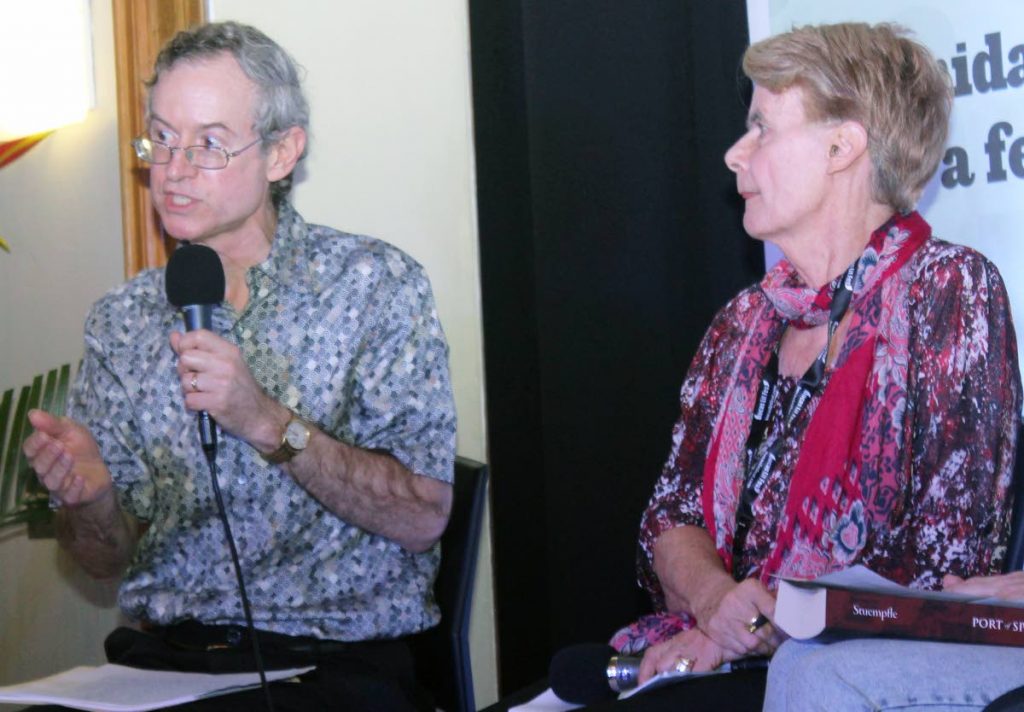A walk through time

MARSHELLE HASELEY
THE Old Fire Station in Port of Spain was not big enough to hold everyone who wanted to participate in a conversation on the history of the city. People from all walks of life came together to hear the discussion with Stephen Stuempfle on his new book, Port of Spain: The Construction of a Caribbean City, 1888-1962.
The panel included writer and Newsday editor in chief Judy Raymond, who moderated the conversation, conservation architect Rudylynn Roberts, and Professor Emerita Bridget Brereton of UWI, St Augustine.
Raymond initiated the talk by saying, “People imagine that our history is hard to dig up, but if you look in the right places it is actually not that hard at all.”
Stuempfle agreed, but added: “I think it requires a lot of imagination. You have to try to figure what might have happened, which guides where you would go for sources. As you get deeper and deeper into sources, they suggest other sources – and it is a never-ending project. There is a vast amount of material.”
He also mentioned sources many in the audience were unlikely to have heard before. “The archives are not only in TT. The Americans had a strong presence here during World War II and that generated quite a bit of archives itself. Port of Spain was the hub of a massive base-building initiative. The army published its own official newspaper, Trinidad News Tips...which recorded the WWII experience in TT extensively.”
ALL ABOUT THE CITY
He also referred to fiction that also added to the body of references, which included work from writers such as VS Naipaul.
Insisting, “It is absolutely an academic book,” Brereton said the last two chapters stood out for her. They discussed the post-war period leading up to independence.
“It is like a nostalgic trip. Some of the chapters read like an extremely informed and erudite guidebook, going from street to street and building to building.
“As a historian, the book reflects one of the more recent trends in writing about Caribbean history, which is moving away from an almost exclusive focus on the plantation, and the rural life, to the history of the city. The book fits in an emerging genre of Caribbean history writing, which we could loosely call urban history. Port of Spain did dominate TT history, politically, socially and demographically.”
She said the representation of the city and how it changed over time was well documented and discussed in the book by photography, plans, architects’ plans, sketches and drawings.
Roberts said the book was amazing for planners and architects. “For every street, neighbourhood and district, there is a story.”
Roberts said Stuempfle brought out the reason for the development, how people felt about it at the time, and what the buildings looked like.
“There is just as much social history as there are interesting stories about individuals. I liked that the book is now a one-stop-shop for information on Port of Spain.”
WALK IN TIME
She was particularly intrigued by the transition from colonial to modern architecture, and how the citizens influenced the development of the city.
“Even the fact that Trinity Cathedral was originally built in the middle of Woodford Square, and people objected to that because they felt that it was a public square and one denomination should not dominate, which eventually resulted in it being dismantled brick by brick and reconstructed it in a new space.”
The panellists all agreed the book is as much a work of social history as cultural geography, and illustrated how much, yet how little Port of Spain and its inhabitants have changed. The freedom of the press of the time, and spaces like the calypso tents, Queen’s Park Savannah and the Botanic Gardens were all topical over a century ago.
. Stuempfle said there was constant negotiation of spaces in the city: what was done where, and by whom.
Raymond asked Stuempfle what most stood out for him while writing the book. He said, “There was a feeling that Port of Spain was not as well known and as appreciated as it should have been.”
He said people thought it was actually a much more Caribbean important city than a lot of people outside TT understood. So the city leaders constantly tried to push its status.
“Even though there were tensions in the society, there was strong civic consciousness. People felt that they were part of a single community.
“And that through collective efforts, the city and the society could be better. That is one thing that struck me most, because, given the extreme social inequality, I did not expect to hear that type of language in so many documents.”
COMBINATION
OF INFLUENCES
An issue connected to the development of Port of Spain which is topical today has to do with the conservation of “gingerbread houses.” Roberts said, “A lot of the ideas in fretwork come from the colonies. They come from China, India, North Africa and the Middle East. What happened was that the colonial architects took those ideas and added their own ideas to it, and we took it and added our African mojo to it. We created a kind of fretwork indigenous to TT – a combination of the influences.”
Stuempfle told Newsday he was also fascinated by the city’s wide range of design ideas.
“There was an incredible variety of concepts about how to build different types of buildings, how to build streets, parks, utilities, electrical and water supplies – all of this energy that came from this wide range of individuals who had a vision of what the city could become; and their conversations, intersections and clashes produced one of the richest and most varied landscapes in a fairly small geographic area, one of the most creative landscapes I have ever seen anywhere in the world.”


Comments
"A walk through time"